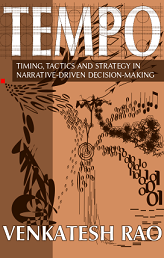In a few weeks I’m going to become a dad. I’ve been feeling a new urgency to imagine what life might be like for a person born native to this weird atemporal era. But what that really means remains speculative until, well, she arrives. So in anticipation for this new world of a person entering my life, and in the spirit of this month’s timely Refactor Camp exploring the fertile side of Escaping Reality, I thought it’d be fun to imagine: what would living in a culture of Worlding feel like?













